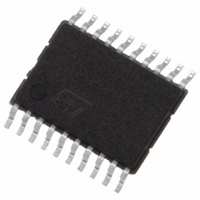STPM11ATR STMicroelectronics, STPM11ATR Datasheet - Page 31

STPM11ATR
Manufacturer Part Number
STPM11ATR
Description
IC ENERGY METER 1 PHASE 20TSSOP
Manufacturer
STMicroelectronics
Datasheet
1.STPM13ATR.pdf
(46 pages)
Specifications of STPM11ATR
Input Impedance
100 KOhm
Measurement Error
0.1%
Voltage - I/o High
1.5V
Voltage - I/o Low
0.8V
Current - Supply
4.7mA
Voltage - Supply
3 V ~ 5.5 V
Operating Temperature
-40°C ~ 85°C
Mounting Type
Surface Mount
Package / Case
20-TSSOP
Meter Type
Single Phase
Output Voltage
+/- 0.4 V
Output Current
150 mA
Input Voltage
3 V to 5.5 V
Operating Temperature Range
- 40 C to + 85 C
Mounting Style
SMD/SMT
Lead Free Status / RoHS Status
Lead free / RoHS Compliant
Other names
497-5984-2
STPM11, STPM12, STPM13, STPM14
The condition in which SCS, SYN-NP and SCL-NLC inputs are set to high level determines
the idle state of the CFGI interface and no data transfer occurs.
Any pin above has internal weak pull up device of nominal 15 A. This means that when a pin
is not forced by external signals, the state of the pin is logic high. A high state of any input
pin above is considered as an idle (not active) state. For the CFGI to operate correctly, the
STPM1x must be correctly supplied as described in the power supply section. When SCS is
active (low), signal SDA-TD should change its state at trailing edge of signal SCL-NLC and
the signal SDA-TD should be stable at the next leading edge of signal SCL-NLC. The first
valid bit of SDA-TD always starts with the activation of signal SCL-NLC.
Writing procedure
Each writable bit (configuration and mode bits) has its own 6-bit absolute address. For the
configuration bits, the 6-bit address value corresponds to its decimal value, while for the
mode bits, the addresses are the ones indicated in the Mode Signal paragraph (7.16).
In order to change the latch state, a byte of data must be sent to STPM1x via CFGI. This
byte consists of 1-bit data to be latched (msb), followed by 6-bit address of destination latch,
followed by 1-bit don't care data (lsb) which totals 8 bits of command byte.
For example, if we would like to set the configuration bit 52 (additional gain of 8) to 1, we
must convert the decimal 52 to its 6-bit binary value: 110100. The byte command will be
then composed like this:
1 bit DATA value+6-bits address+1 bit (0 or 1) as depicted in
binary command will be 11101000 (0xE8) or 11101001 (0xE9).
– SCS: in the STPM1X, the SYN-NP, SCL-NLC and SDA-TD have the dual task to
– SYN-NP: this pin allows synchronization of the communication between STPM1x and
– SCL-NLC: it is basically the clock pin of the CFGI interface. This pin function is also
– SDA-TD is the Data pin. SDA-TD is the input of the serial bit data signal.
provide information on the meter status (see Pin Description table) and to allow CFGI
communication. The SCS pin allows using the above pins for CFGI communication
when it is low and allows the normal operation of SYN-NP, SCL-NLC and SDA-TD
when it is high. In this section, the SYN-NP, SCL-NLC and SDA-TD operation as part
of the CFGI interface is described.
the host. See
controlled by the SCS status. If SCS is low, SCL-NLC is the input of the serial bit
synchronization clock signal. When SCS is high, SCL-NLC is also high which
determines the idle state of the CFGI.
Figure 21
Doc ID 13167 Rev 7
- for detailed timing of the pin.
Figure
21. In this case the
Theory of operation
31/46












